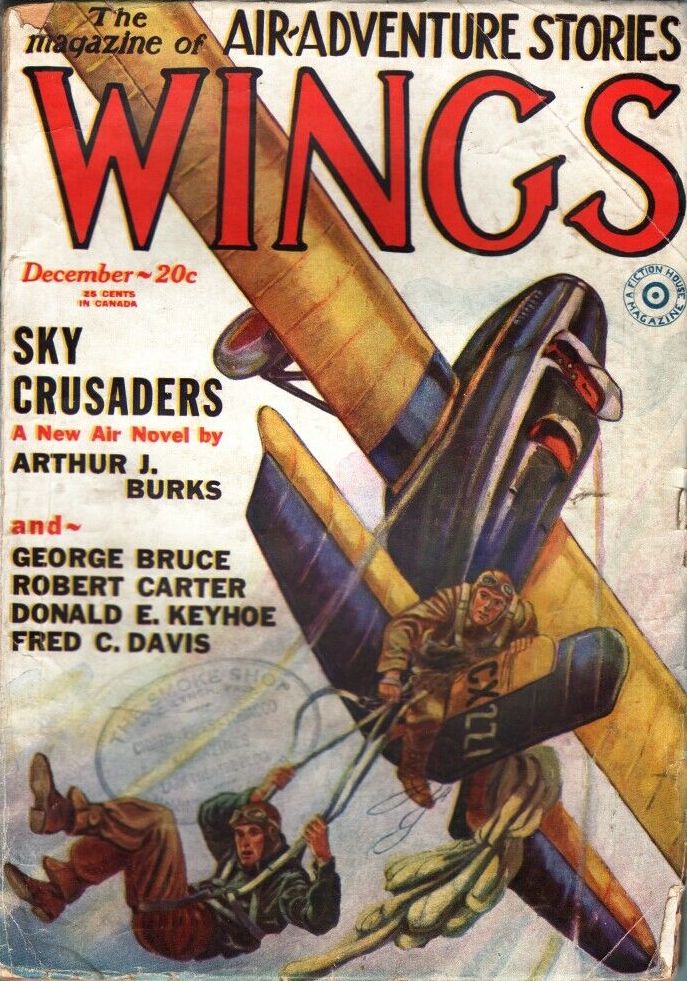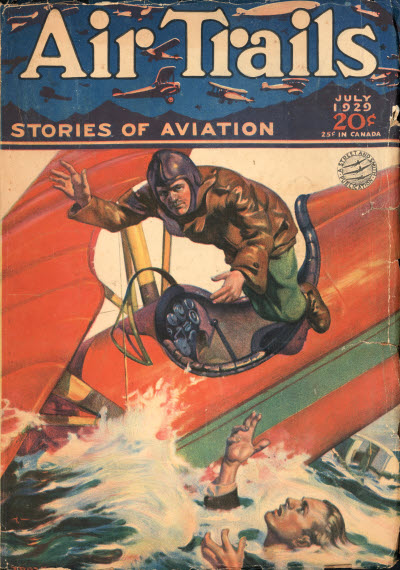The Pulp Plagiarism Scandal of 1929
IF FRIDAY’S story seemed a little  familiar to you, there may be a reason for that. The entire story was plagiarized from another. In this case it was Ben Conlon’s “Flyers of Fortune” (Air Trails, July 1929). Yes, Carter’s “Fortune Flyers” was a virtual word for word rip off of Conlon’s earlier story.
familiar to you, there may be a reason for that. The entire story was plagiarized from another. In this case it was Ben Conlon’s “Flyers of Fortune” (Air Trails, July 1929). Yes, Carter’s “Fortune Flyers” was a virtual word for word rip off of Conlon’s earlier story.
Everything seemed to be going Robert A. Carter’s way. A former Canadian war time ace, he was Married in 1925, with a girl born the following year, the former Canadian war time ace had found a way to profit off his past experiences by not only editing two of Fiction House’s Aviation pulps—Air Stories and Wings, but he was also getting his own stories in including a 14 part series on “How to Become a Pilot” that ran in both magazines.
Toward the end of 1928, it all started to unravel.
Turns out that loving wife and child was more of a ball and chain to Carter who found he preferred the company of his friends over them. As the Port Chester Daily Item reported on January 12th:
Alimony of $35 a week and counsel fees of $500 must be paid to Mrs. Michelena Carter, of 88 Chatswood Avenue, Larchmont, by her husband, Robert A. Carter, editor of aeronautical fiction magazines, according to award made here by Supreme Court Justice George H. Taylor, Jr., in Special Term. The award was made by default as no opposition was presented by the husband.
According to the wife’s complaint, she married Carter on August 6, 1925, at Catskill and they have lived since in this county. There is one child, Mary Elizabeth, born November 17, 1926.
Carter, according to his wife, is thirty years of age and is employed by the Fiction House, Inc., 271 Madison Avenue, New York City. as editor of two aeronautical fiction magazines, “Wings” and “Air Stories.” He receives a salary of $40 weekly, she alleges, and from $25 to $60 for each story he furnishes the magazines.
Basing her plea for separation on the grounds of cruelty and abandonment, Mrs. Carter alleges that without cause or provocation, Carter absented himself from their Larchmont home for several nights a week from August to December of last year. Even the Christmas holiday was spent away from home, she says, her husband telling her he preferred to spend his time with friends.
On December 28th, she says, he packed his clothes and left with the statement that he did not intend to return and that he was “through” with her. She alleges that he left no money for her needs, that her baby is ill, and that she is without funds with which to purchase medicines or the services of a physician.
The alimony awarded is pending the trial of the separation action.
Although the home life may have fallen apart, his writing career seemed to flourish as he started to see print in other titles—Aces, Air Trails, Flying Aces and War Birds. Which is good, since Carter and his estranged wife entered into a stipulation on June 4th whereby he was to pay $40 weekly out of his $100 weekly earnings as a magazine writer and the daring hero of many magazine exploits in the air.
He lived up to the agreement for two weeks before disappearing sight unseen.
Maybe this is why he was so hard to pin down and seemed a little cagey in that Air Trail’s biographical piece from November 1929. Or maybe it was the fact that he had already plagiarized several stories and submitted them to his boss at Fiction House, John B. Kelly as his own! And with the publication of the December 1929 issue of Wings, it all hit the fan!

The Stories in Question. The opening pages of Ben Conlon’s “Flyers of Fortune” (Air Trails, July 1929) and Robert A. Carter’s “Fortune Flyers” (Wings, December 1929)
The Port Chester Daily Item reports (on the front page!):
When the Muse failed and he resorted to plagiarism to keep the candle burning at both ends Robert A. Carter, thirty-two, self styled World War aviator, who is well known in Harrison and Rye, let himself in for plenty of trouble. He was lodged in the Tombs Prison in New York City today, charged with grand larceny as the result of a confession that he copied aviation stories verbatim from one magazine and sold them to another.
The specific instance on which the charge is based concerns the story “Flyers of Fortune,” by Ben Conlin, published in “Air Trails.” Carter is alleged to have copied it word for word and sold it to the magazine “Wings” under the title “Fortune Flyers.” For it he received $240 from John B. Kelly, head of Fiction House, Inc., of 271 Madison Avenue, New York City.
Carter, who formerly lived in Harrison, was arrested by a detective from the office of Assistant District Attorney Edward Laughlin at his home, 25 East 30th Street. He was indicted by the grand Jury on a grand larceny charge and a bench warrant issued for his arrest. The Indictment was based mainly on a written confession to Kelly, in which Carter admitted having plagiarized the story as well as two others.
According to Kelly, Carter came to him about two and a half years ago and asked for a job. He said be had served in the Royal Flying Corps in Italy during the war and thought he could write stories of his experiences. He was given a Job and his stories, when published, were enthusiastically received. He was soon made managing editor of “Wings” and a little later arranged a broadcast from the Hotel Roosevelt in which he introduced several famous wa races. He also did some work for a Brooklyn station and later represented himself as the director, which was the first Intimation that Kelly had of his duplicity.
Kelly estimated Carter managed to extract $1,100 from the company through his plagiaristic efforts.
After his apprehension, it was discovered that fiction filching was the most remunerative, but not the exclusive manner of his making a living. Two Manhattan hotels had $850 worth of bad bills against him.
Convicted of the charges petty larceny, Plagiarist Carter was sentenced to serve not less than six months, nor more than three years in the penitentiary.
The 1930 US Census lists Robert A. Carter as an inmate of Cell Block A at the Hart Island Reformatory Prison in the Bronx.
This story was big news. Although it never received large splashy headlines, Carter’s plagiarism was reported in papers as if it had just happened well into 1932. It even made Time magazine—twice! Once in the 23 December 1929 issue and a more detailed piece two months later in the 24 February 1930 issue.





 exciting air adventure from the pen of Ben Conlon. Conlon was quite the prolific author contributing stories in many genres and under a number of pseudonyms. He’s maybe best remembered for his many exciting Pete Rice western tales. He wrote all the full-length Pete Rice stories under the name Austin Gridley. Others used the pen name for the shorter Pete Rice stories in Wild West Weekly.
exciting air adventure from the pen of Ben Conlon. Conlon was quite the prolific author contributing stories in many genres and under a number of pseudonyms. He’s maybe best remembered for his many exciting Pete Rice western tales. He wrote all the full-length Pete Rice stories under the name Austin Gridley. Others used the pen name for the shorter Pete Rice stories in Wild West Weekly.